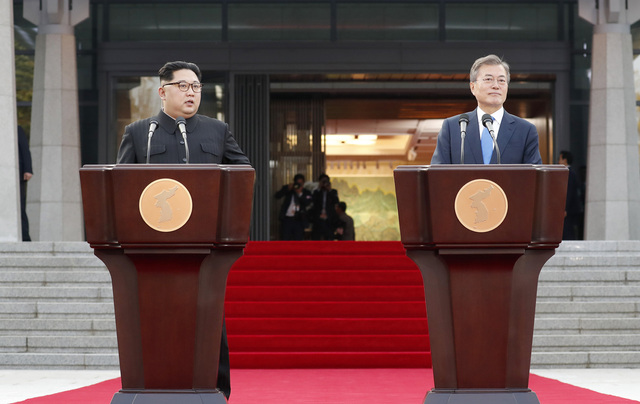 |
|
South Korean President Moon Jae-in and North Korean leader Kim Jong-un announce the contents of the Panmunjeom Declaration, which resulted from the dialogue of the Inter-Korean Summit, in front of the House of Peace in Panmunjeom on Apr. 27. (Blue House photo pool)
|
Has significant overlap with the Inter-Korean Basic Agreement of 1991 and Oct. 4 Summit Declaration of 2007
The Panmunjeom Declaration for Peace, Prosperity and Unification of the Korean Peninsula, which the Blue House started implementing on May 3, has a significant amount of overlap with the Inter-Korean Basic Agreement (which was adopted in 1991 and took effect in 1992) and the Oct. 4 Summit Declaration from 2007. These two historic documents, which became dead letters during the presidencies of Lee Myung-bak and Park Geun-hye, were gloriously revised this year in the Panmunjeom Declaration, which suggests that the Korean Peninsula’s ten-year odyssey toward peace and prosperity has at last reached its destination. This is also evidence that the fate of the Panmunjeom Declaration depends upon its swift and faithful implementation. The Panmunjeom Declaration and the Inter-Korean Basic Agreement even have a similar format. The Panmunjeom Declaration is divided into three articles: improving inter-Korean relations, easing military tensions and mutual non-aggression, and the denuclearization of the Korean Peninsula and the establishment of a peace regime. The Inter-Korean Basic Agreement, which consists of 25 articles in four chapters, also has three main goals: inter-Korean reconciliation, inter-Korean non-aggression, and inter-Korean cooperation and exchange. The two preceding sections contain similar provisions. In particular, Article 2 of the Panmunjeom Declaration, which deals with easing military tensions and mutual non-aggression, and Article 3, which specifies the steps toward building a peace regime, directly borrow relevant phrasing from Chapter 1 (“South-North Reconciliation”) and Chapter 2 (“South-North Non-Aggression”) of the Inter-Korean Basic Agreement. Article 9 of the Basic Agreement (“The two sides shall not use force against each other and shall not undertake armed aggression against each other”) is stipulated in Clause 3 of the Oct. 4 Summit Declaration (firmly adhering to the duty of non-aggression) and Article 3, Clause 1, of the Panmunjeom Declaration. The provision about completely halting hostile acts and turning the DMZ (demilitarized zone) into a peace zone in Article 2, Clause 1, of the Panmunjeom Declaration had earlier been mentioned in Article 12 of the Basic Agreement. The same provision about gradual disarmament appears in both the Panmunjeom Declaration and Inter-Korean Basic Agreement. The joint liaison office that South and North Korea agreed to build in Kaesong in Article 1, Clause 3, of the Panmunjeom Declaration is similar to the Panmunjeom inter-Korean liaison office that appeared in the Inter-Korean Basic Agreement 26 years earlier. “That’s because the Inter-Korean Basic Agreement is something of a Bible for inter-Korean relations,” said Yang Moo-jin, a professor at the University of North Korean Studies. Furthermore, the part of Article 2, Clause 2 of the Panmunjeom Declaration that agrees to “turn the areas around the Northern Limit Line in the West Sea into a maritime peace zone in order to prevent accidental military clashes and guarantee safe fishing activities” was also dealt with in Clause 3 of the Summit Declaration on Oct. 4, 2007. At the time, however, that document only mentioned the “West Sea” without specifying the Northern Limit Line. The section of the Panmunjeom Declaration about economic cooperation (Article 1, Clause 6) actually agrees “to actively implement the projects previously agreed in the 2007 October 4 Declaration.” Panmunjeom Declaration a step forward in denuclearization and peace regime The topics on which the Panmunjeom Declaration advanced beyond the two previous agreements are the denuclearization of the Korean Peninsula and the establishment of a peace regime. The Inter-Korean Basic Agreement (Chapter 1, Article 5) and the Oct. 4 Summit Declaration (Clause 4) express a general agreement to transition from an armistice regime to a peace regime. Whereas the Oct. 4 Summit Declaration referred to the denuclearization issue with a phrase about working to implement the Feb. 13 Agreement (2007) and the Sept. 19 Joint Declaration (2005) from the Six-Party Talks, the Panmunjeom Declaration specifically agrees to “pursue trilateral meetings involving the two Koreas and the United States, or quadrilateral meetings involving the two Koreas, the United States and China with a view to declaring an end to the war and establishing a [. . .] peace regime.” “The inclusion of denuclearization is a definite difference,” said Cho Sung-ryul, senior research fellow for the Institute for National Security. Most importantly, the Panmunjeom Declaration contained the promise to “bring forth the watershed moment [. . .] by fully implementing all existing agreements and declarations adopted between the two sides thus far.” It is also notable that the two leaders learned from the history of agreements that were never implemented and confirmed their determination to implement the agreement by specifying measures to guarantee its implementation, such as a summit in Pyongyang this fall. By Kim Ji-eun, staff reporter Please direct comments or questions to [english@hani.co.kr]






